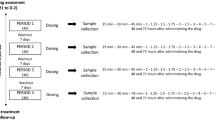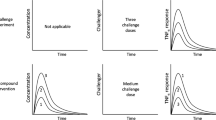Abstract
Objective
To model the pharmacokinetic and pharmacodynamic relationship of bilastine, a new histamine H1 receptor antagonist, from single- and multiple-dose studies in healthy adult subjects.
Methods
The pharmacokinetic model was developed from different single-dose and multiple-dose studies. In the single-dose studies, a total of 183 subjects received oral doses of bilastine 2.5, 5, 10, 20, 50, 100, 120, 160, 200 and 220 mg. In the multiple-dose studies, 127 healthy subjects received bilastine 10, 20, 40, 50, 80, 100, 140 or 200 mg/day as multiple doses during a 4-, 7- or 14-day period.
The pharmacokinetic profile of bilastine was investigated using a simultaneous analysis of all concentrationtime data by means of nonlinear mixed-effects modelling population pharmacokinetic software NONMEM® version 6.1.
Plasma concentrations were modelled according to a two-compartment open model with first-order absorption and elimination.
For the pharmacodynamic analysis, the inhibitory effect of bilastine (inhibition of histamine-induced wheal and flare) was assessed on a preselected time schedule, and the predicted typical pharmacokinetic profile (based on the pharmacokinetic model previously developed) was used. An indirect response model was developed to describe the pharmacodynamic relationships between flare or wheal areas and bilastine plasma concentrations.
Finally, once values of the concentration that produced 50% inhibition (IC50) had been estimated for wheal and flare effects, simulations were carried out to predict plasma concentrations for the doses of bilastine 5, 10 and 20 mg at steady state (72–96 hours).
Results
A non-compartmental analysis resulted in linear kinetics of bilastine in the dose range studied. Bilastine was characterized by two-compartmental kinetics with a rapid-absorption phase (first-order absorption rate constant = 1.50 h-1), plasma peak concentrations were observed at 1 hour following administration and the maximal response was observed at approximately 4 hours or later. Concerning the selected pharmacodynamic model to fit the data (type I indirect response model), this selection is attributable to the presence of inhibitory bilastine plasma concentrations that decrease the input response function, i.e. the production of the skin reaction. This model resulted in the best fit of wheal and flare data. The estimates (with relative standard errors expressed in percentages in parentheses) of the apparent zero-order rate constant for flare or wheal spontaneous appearance (kin), the first-order rate constant for flare or wheal disappearance (kout) and bilastine IC50 values were 0.44ng/mL/h (14.60%), 1.09 h-1 (15.14%) and 5.15 ng/mL (16.16%), respectively, for wheal inhibition, and 11.10 ng/mL/h (8.48%), 1.03 h-1 (8.35%) and 1.25 ng/mL (14.56%), respectively, for flare inhibition.
The simulation results revealed that bilastine plasma concentrations do not remain over the IC50 value throughout the inter-dose period for doses of 5 and 10 mg. However, with a dose of 20 mg of bilastine administered every 24 hours, plasma concentrations remained over the IC50 value during the considered period for the flare effect, and up to 20 hours for the wheal effect.
Conclusion
Pharmacokinetic and pharmacodynamic relationships of bilastine were reliably described with the use of an indirect response pharmacodynamic model; this led to an accurate prediction of the pharmacodynamic activity of bilastine.










Similar content being viewed by others
References
Corcóstegui R, Labeaga L, Innerárity A, et al. Preclinical pharmacology of bilastine, a new selective histamine H1 receptor antagonist: receptor selectivity and in vitro antihistaminic activity. Drugs 2005; 6: 371–87
Corcóstegui R, Labeaga L, Innerárity A, et al. In vivo pharmacological characterisation of bilastine, a potent and selective histamine H1 receptor antagonist. Drugs 2006; 7: 219–31
Simons FER, Simons KJ. Clinical pharmacology of new histamine H1 receptor antagonists. Clin Pharmacokinet 1999; 36: 329–52
Rosenzweig P, Caplain H, Chaufour S, et al. Comparative wheal and flare study of mizolastine vs terfenadine, cetirizine, loratadine and placebo in healthy volunteers. Br J Clin Pharmacol 1995; 40: 459–65
Harvey RP, Schocket AL. The effect of H1 and H2 blockade on cutaneous histamine response in man. J Allergy Clin Inmunol 1980; 65: 136–9
Simons FER, McMillan JL, Simons KJ. A double-blind, single dose, crossover comparison of cetirizine, terfenadine, loratadine, astemizole, and chlor-pheniramine versus placebo: suppressive effects on histamine-induced wheals and flares during 24 hours in healthy subjects. J Allergy Clin Inmunol 1990; 86: 540–7
Heykants JJP, Snoeck E, Awouters F, et al. Antihistamines. In: Van Boxtel CJ, Holford NHG, Danhof M, editors. The in vivo study of drug action. Amsterdam: Elsevier Science Publishers, 1992: 337–56
Devillier P, Bousquet J. Inhibition of the histamine-induced weal and flare response: a valid surrogate measure for antihistamine clinical efficacy? Clin Exp Allergy 2007; 37: 400–14
Kuna P, Nowacki Z, van Cauwenberge P, et al. A phase study comparing the efficacy and safety of once daily bilastine with cetirizine and placebo for the treatment of seasonal allergic rhinitis. Allergy 2007; 62: 132–3
Holford NHG, Sheiner LB. Understanding the concentration-effect relationship: clinical application of pharmacokinetic-pharmacodynamic models. Clin Pharmacokinet 1981; 6: 429–53
Deschamps C, Dubruc C, Mentre F, et al. Pharmacokinetic and pharmacodynamic modeling of mizolastine in healthy volunteers with an indirect response model. Clin Pharmacol Ther 2000; 68: 647–57
Urien S, Tillement JP, Ganem B. A pharmacokinetic-pharmacodynamic modelling of the antihistaminic (H1) effects of cetirizine. Int J Clin Pharmacol Ther 1999; 37: 499–502
Roupe K, Sologuren A, Crean C, et al. The pharmacokinetics of bilastine after single and 14 days once daily administration [abstract]. Basic Clin Pharmacol Toxicol 2007; 101 Suppl. 1: 148
Sologuren A, Valiente R, Crean C, et al. Relationship of dose to inhibition of wheal and flare for 5 doses of bilastine and 10 mg cetirizine [abstract no. 69]. J Clin Pharmacol 2007; 47(9): 1198
Roupe K, Sologuren A, Crean C, et al. Effect of age and gender on the pharmacokinetics and pharmacodynamics of bilastine [abstract no. 70]. J Clin Pharmacol 2007; 47(9): 1198
Antonijoan RM, García-Gea C, Puntes M, et al. Estudio farmacocinética y de actividad antihistamínica H1 de bilastina tras su administración única y repetida en voluntarios sanos. XIX Congress of the Spanish Society of Clinical Pharmacology; 2004 Oct 28–30; Santander
Sologuren A, Crean C, Valiente R, et al. The drug-drug interaction of ketoconazole on bilastine pharmacokinetics [abstract plus poster no. 476]. Basic Clin Pharmacol Toxicol 2007; 101 Suppl. 1: 148
Crean C, Valiente R, Sologuren A, et al. Effect of grapefruit juice on the pharmacokinetics of bilastine [abstract no. 71]. J Clin Pharmacol 2007; 47(9): 1198
Beal SL, Boeckmann AJ, Sheiner LB, editors. NONMEM user guides. San Francisco (CA): NONMEM Project Group, University of California, 1992
Levy G. Mechanism-based pharmacodynamic modelling. Clin Pharmacol Ther 1994; 56: 356–8
Purohit A, Melac M, Pauli G, et al. Comparative activity of cetirizine and mizolastine on histamine-induced skin wheal and flare responses at 24 h. Br J Clin Pharmacol 2002; 53: 250–4
Bousquet J, Chanal I, Murrieta M, et al. Lack of sensitivity to mizolastine over 8-week treatment. Allergy 1996; 51: 251–6
Pinquier JL, Caplain H, Cabanis MJ, et al. Inhibition of histamine-induced skin wheal and flare after 5 days of mizolastine. J Clin Pharmacol 1996; 36: 72–8
Devalia JL, De Vos C, Hanotte F, et al. A randomized, double-blind crossover comparison among cetirizine, levocetirizine, and UCB 28557 on histamine-induced cutaneous responses in healthy adult volunteers. Allergy 2001; 56: 50–7
Dayneka NL, Garg V, Jusko WJ. Comparison of four basic models of indirect pharmacodynamic responses. J Pharmacokinet Biopharm 1993; 21: 457–78
Sharma A, Jusko WJ. Characteristics of indirect pharmacodynamic models and applications to clinical drug responses. Br J Clinical Pharmacol 1998; 45: 229–39
Acknowledgements
The authors would like to thank Deirdre McLaverty and A.J. Stewart (MDS Pharma Services Belfast, Northern Ireland), and M.J. Barbanoj, R.M. Antonijoan and C. García-Gea (Centre d’Investigació de Medicaments, Institut de Recerca de l’Hospital de la Santa Creu i Sant Pau, Barcelona, Spain) as the principal investigators of the different studies. The authors received no funding for the conduct of this study. Nerea Jauregizar and Leire de la Fuente are employees of Pharma Datum Data Análisis SL; Nerea Leal and Mónica Rodríguez are employees of DynaKin; and M. Luisa Lucero and Ander Sologuren are employees of FAES FARMA SA The authors have no other conflicts of interest that are directly relevant to the content of this study.
Author information
Authors and Affiliations
Corresponding author
Rights and permissions
About this article
Cite this article
Jauregizar, N., de la Fuente, L., Lucero, M.L. et al. Pharmacokinetic-Pharmacodynamic Modelling of the Antihistaminic (H1) Effect of Bilastine. Clin Pharmacokinet 48, 543–554 (2009). https://doi.org/10.2165/11317180-000000000-00000
Published:
Issue Date:
DOI: https://doi.org/10.2165/11317180-000000000-00000




